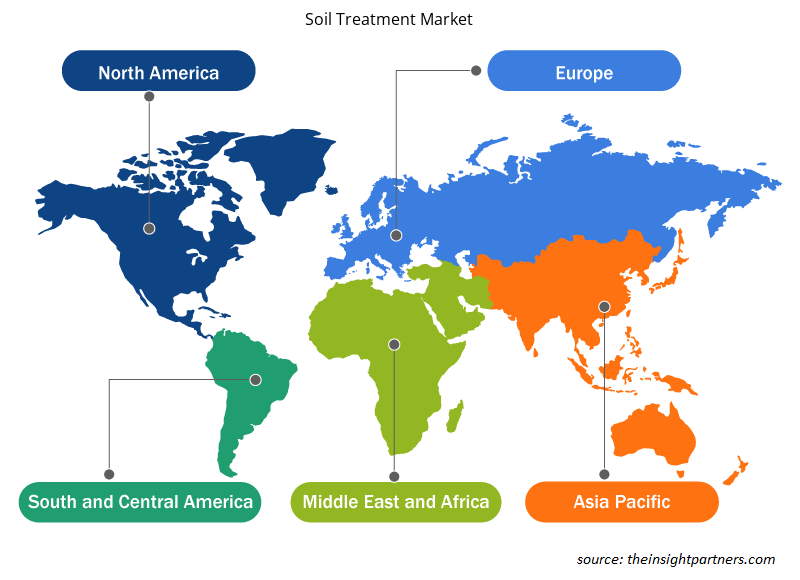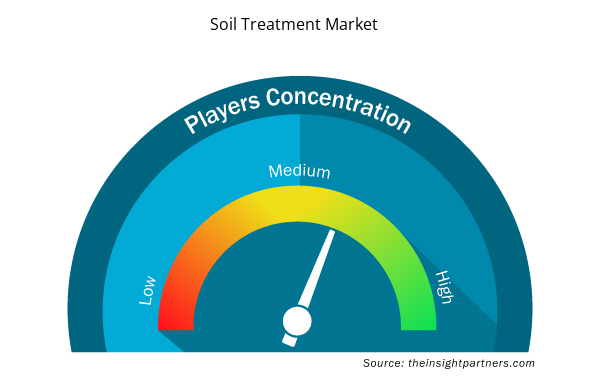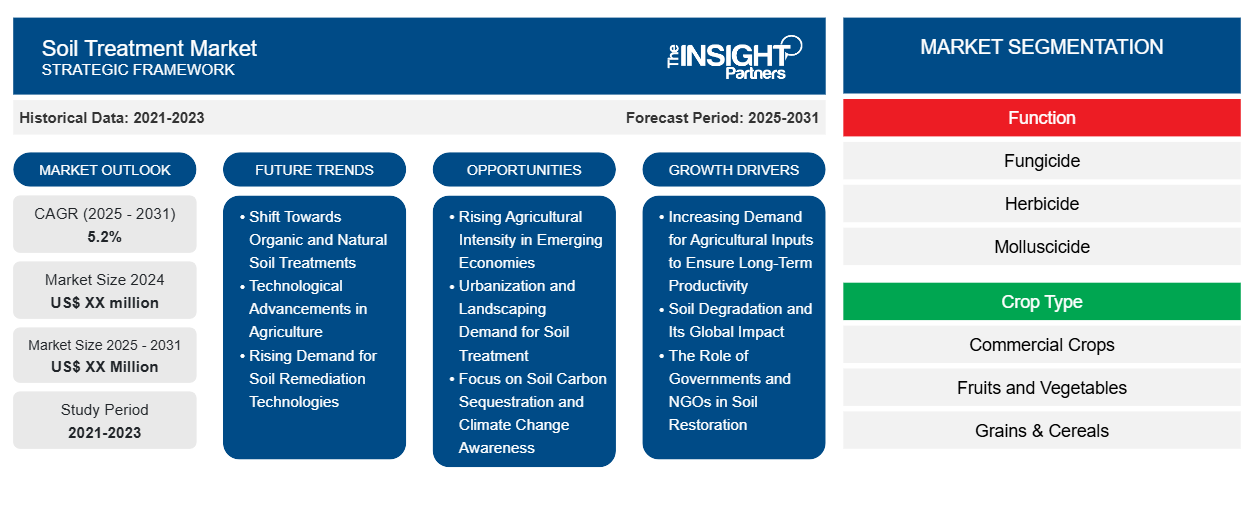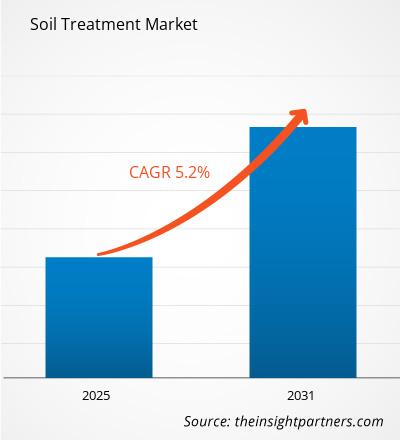Es wird erwartet, dass der Markt für Bodenbehandlung von 2024 bis 2031 eine durchschnittliche jährliche Wachstumsrate (CAGR) von 5,2 % verzeichnet, wobei die Marktgröße von XX Millionen US-Dollar im Jahr 2024 auf XX Millionen US-Dollar im Jahr 2031 anwachsen wird.
Der Bericht ist nach Funktion segmentiert (Fungizid, Herbizid, Molluskizid, Insektizid und Nematizid). Der Bericht enthält außerdem eine Analyse basierend auf der Pflanzenart (kommerzielle Pflanzen, Obst und Gemüse, Getreide und Cerealien, Hülsenfrüchte und Ölsaaten sowie Rasen und Zierpflanzen). Der Berichtsumfang umfasst fünf Regionen: Nordamerika, Europa, Asien-Pazifik, Naher Osten und Afrika sowie Süd- und Mittelamerika und Schlüsselländer in jeder Region. Die globale Analyse ist weiter auf regionaler Ebene und nach wichtigen Ländern aufgeschlüsselt. Der Bericht bietet den Wert in USD für die oben genannte Analyse und Segmente.
Zweck des Berichts
Der Bericht „Markt für Bodenbehandlung“ von The Insight Partners zielt darauf ab, die aktuelle Situation und das zukünftige Wachstum sowie die wichtigsten treibenden Faktoren, Herausforderungen und Chancen zu beschreiben. Dies wird verschiedenen Geschäftspartnern Einblicke geben, wie zum Beispiel:
- Technologieanbieter/-hersteller: Um die sich entwickelnde Marktdynamik zu verstehen und die potenziellen Wachstumschancen zu kennen, damit sie fundierte strategische Entscheidungen treffen können.
- Investoren: Durchführung einer umfassenden Trendanalyse hinsichtlich der Marktwachstumsrate, der finanziellen Marktprognosen und der Chancen entlang der Wertschöpfungskette.
- Regulierungsbehörden: Zur Regulierung von Richtlinien und Überwachungsaktivitäten auf dem Markt mit dem Ziel, Missbrauch zu minimieren, das Vertrauen der Anleger zu bewahren und die Integrität und Stabilität des Marktes aufrechtzuerhalten.
Bodenbehandlung Marktsegmentierung
Funktion
- Fungizid
- Herbizid
- Molluskizid
- Insektizid
- Nematizid
Pflanzenart
- Kommerzielle Nutzpflanzen
- Obst und Gemüse
- Getreide und Cerealien
- Hülsenfrüchte und Ölsaaten
- Rasen und Zierpflanzen
Passen Sie diesen Bericht Ihren Anforderungen an
Sie erhalten kostenlos individuelle Anpassungen an jedem Bericht, einschließlich Teilen dieses Berichts oder einer Analyse auf Länderebene, eines Excel-Datenpakets sowie tolle Angebote und Rabatte für Start-ups und Universitäten.
- Holen Sie sich die wichtigsten Markttrends aus diesem Bericht.Dieses KOSTENLOSE Beispiel umfasst eine Datenanalyse von Markttrends bis hin zu Schätzungen und Prognosen.
Wachstumstreiber auf dem Markt für Bodenbehandlung
- Steigende Nachfrage nach landwirtschaftlichen Betriebsmitteln zur Sicherstellung einer langfristigen Produktivität: Angesichts der wachsenden Weltbevölkerung erfordert der Bedarf an landwirtschaftlichen Produkten eine höhere Bodenbearbeitung, um eine langfristige landwirtschaftliche Produktivität und die Verfügbarkeit einer nachhaltigen Nahrungsmittelproduktion zu gewährleisten. Düngung, pH-Anpassung und organische Bodenverbesserungsmittel sind von entscheidender Bedeutung, da sie die Bodengesundheit und die Maximierung der Ernteerträge beeinflussen und eine langfristige landwirtschaftliche Produktivität und Ertragssteigerung gewährleisten. Hohe landwirtschaftliche Erträge erfordern eine effizientere Lösung für ihre Behandlung.
- Bodenerosion und ihre globalen Auswirkungen: Übernutzung landwirtschaftlicher Flächen, Abholzung, Industrialisierung und globale Erwärmung in Verbindung mit Bodenerosion bedrohen die Welt. Die größten Herausforderungen in diesem Zusammenhang sind Bodenerosion, Nährstoffmangel und Kontamination. Dies erforderte die Einführung von Bodenkonditionierung, Bodenerosionskontrolle und Sanierung, um so die Wiederherstellung und Erhaltung gesunder Böden zu verbessern. Regierungen, NGOs und mit der Agrarindustrie verbundene Industrien haben ein Interesse daran, den Boden zu behandeln, um die angesammelten negativen Auswirkungen der Folgen unsachgemäßer Bodenbewirtschaftung rückgängig zu machen.
- Die Rolle von Regierungen und NGOs bei der Bodensanierung: Das zunehmende Bewusstsein für Umweltfaktoren und strenge staatliche Vorschriften zur Bodenbehandlung mit nachhaltigen landwirtschaftlichen Produkten treiben die Einführung von Bodenbehandlungsprodukten voran. Organische und umweltfreundliche Behandlungen sind für Landwirte die erste Wahl, da sie dazu neigen, Chemikalien in der Landwirtschaft nur minimal einzusetzen und die Verschmutzung von Boden und Wasser zu vermeiden. Landwirtschaftsvorschriften verlangen bei der Bodenbehandlung die strikte Einhaltung landwirtschaftlicher Grundsätze für eine sichere und gesunde Landwirtschaft.
Zukünftige Trends auf dem Bodenbehandlungsmarkt
- Umstellung auf organische und natürliche Bodenbehandlungen: Organische und natürliche Bodenbehandlungen wie Kompost, Biokohle und pflanzliche Düngemittel nehmen zu. Dies liegt daran, dass Verbraucher mehr Bioprodukte bevorzugen und strengere Umweltvorschriften eine ungiftige und nachhaltige Bodenbewirtschaftung vorschreiben. Biobasierte Bodenbehandlungen nehmen auch deshalb zu, weil sie umweltfreundlicher und sicherer sind als synthetische chemische Produkte.
- Technologische Fortschritte in der Landwirtschaft: Neue Technologien und ihre Nutzung in der Landwirtschaft verändern die Art und Weise, wie der Boden behandelt wird. Datenanalysen, IoT-Geräte, Drohnen und andere Sensoren dominieren die Möglichkeiten der Präzisionslandwirtschaft. Mithilfe gezielter Behandlungen wird auch eine zeitnahe Überwachung der Bodenbedingungen durchgeführt. Diese Technologien stellen sicher, dass Bodendünger nicht verschwendet werden, indem sie den Abfall minimieren und eine optimale allgemeine Effizienz bei der Bodenbehandlung erreichen. Der Einsatz zugänglicherer Technologien wird wahrscheinlich die Beteiligung dieser Technologie am Markt für Bodenbehandlung steigern.
- Steigende Nachfrage nach Bodensanierungstechnologien: Die steigende Nachfrage nach Bodensanierungstechnologien wird durch Bodenkontamination mit Schwermetallen, Pestiziden, Industrieabfällen und anderen Schadstoffen ausgelöst. Die stetig steigende Nachfrage nach umweltfreundlichen Sanierungstechnologien wie Bioremediation und Phytoremediation zur Dekontaminierung und Wiederbelebung verschmutzter Böden zeigt erste Anzeichen für eine Marktstärke. Die Hauptantriebskräfte hinter diesem Trend sind ein gesteigertes Umweltbewusstsein, neue Gesetze in Bezug auf industrielle Verschmutzung und die Notwendigkeit sauberer, gesunder Böden für die Landwirtschaft und städtische Bedürfnisse.
Marktchancen für Bodenbehandlung
- Steigende landwirtschaftliche Intensität in Schwellenländern: Die steigende landwirtschaftliche Intensität in Schwellenländern, insbesondere im asiatisch-pazifischen Raum, in Lateinamerika und Afrika, führt zu einer steigenden Nachfrage nach Bodenbehandlungstechnologien. Genau die Probleme, die diese Schwellenländer plagen – schlechte Bodenbewirtschaftungspraktiken und Überbewirtschaftung in vielen Teilen von ihnen – bieten Unternehmen im Bereich Bodenbehandlungstechnologien wie organische Zusätze, pH-Kontrolle und Wiederherstellung der Bodengesundheit Chancen.
- Bedarf an Bodenbehandlung durch Urbanisierung und Landschaftsbau: Mit zunehmender Urbanisierung und Kommerzialisierung steigt der Bedarf an Bodenbehandlung bei Landschaftsbauprojekten immer weiter an. Sie ist zu einer wesentlichen Voraussetzung geworden, um das Wachstum von Pflanzen unter rauen städtischen Bedingungen zu unterstützen, von Stadtparks bis hin zu Gründächern und Sportplätzen. Bodenverbesserer, Düngemittel und Materialien zur Erosionskontrolle sind von entscheidender Bedeutung, um gesunde, nachhaltige Städte zu erhalten. Dies wiederum wird zu einer neuen Marktentwicklungschance für die Unternehmen, die den Boden behandeln.
- Fokus auf Kohlenstoffbindung im Boden und Bewusstsein für den Klimawandel: Mit dem wachsenden Bewusstsein für den Klimawandel steigt auch der Fokus auf die Kohlenstoffbindung im Boden langsam, aber stetig. Dazu gehören große Mengen an Biokohle, Kompost und Deckfrüchten, die die Aufnahme- und Speicherfähigkeit des Bodens verbessern können. Solche Methoden gewinnen im Rahmen größerer Initiativen für Kohlenstofflandwirtschaft an Anerkennung und eröffnen Unternehmen, die Bodenbehandlungen entwickeln, die die Kohlenstoffbindung unterstützen, neue Möglichkeiten.
Regionale Einblicke in den Bodenbehandlungsmarkt
Die regionalen Trends und Faktoren, die den Bodenbehandlungsmarkt im Prognosezeitraum beeinflussen, wurden von den Analysten von Insight Partners ausführlich erläutert. In diesem Abschnitt werden auch die Marktsegmente und die Geografie des Bodenbehandlungsmarkts in Nordamerika, Europa, im asiatisch-pazifischen Raum, im Nahen Osten und Afrika sowie in Süd- und Mittelamerika erörtert.

- Erhalten Sie regionale Daten zum Bodenbehandlungsmarkt
Umfang des Marktberichts zur Bodenbehandlung
| Berichtsattribut | Details |
|---|---|
| Marktgröße im Jahr 2024 | XX Millionen US-Dollar |
| Marktgröße bis 2031 | XX Millionen US-Dollar |
| Globale CAGR (2025 - 2031) | 5,2 % |
| Historische Daten | 2021-2023 |
| Prognosezeitraum | 2025–2031 |
| Abgedeckte Segmente | Nach Funktion
|
| Abgedeckte Regionen und Länder | Nordamerika
|
| Marktführer und wichtige Unternehmensprofile |
|
Dichte der Marktteilnehmer im Bereich Bodenbehandlung: Die Auswirkungen auf die Geschäftsdynamik verstehen
Der Markt für Bodenbehandlung wächst rasant, angetrieben durch die steigende Nachfrage der Endverbraucher aufgrund von Faktoren wie sich entwickelnden Verbraucherpräferenzen, technologischen Fortschritten und einem größeren Bewusstsein für die Vorteile des Produkts. Mit steigender Nachfrage erweitern Unternehmen ihr Angebot, entwickeln Innovationen, um die Bedürfnisse der Verbraucher zu erfüllen, und nutzen neue Trends, was das Marktwachstum weiter ankurbelt.
Die Marktteilnehmerdichte bezieht sich auf die Verteilung der Firmen oder Unternehmen, die in einem bestimmten Markt oder einer bestimmten Branche tätig sind. Sie gibt an, wie viele Wettbewerber (Marktteilnehmer) in einem bestimmten Marktraum im Verhältnis zu seiner Größe oder seinem gesamten Marktwert präsent sind.
Die wichtigsten auf dem Markt für Bodenbehandlung tätigen Unternehmen sind:
- ADAMA Agricultural Solutions Ltd.
- Amerikanische Vanguard Corporation
- Arkema SA
- BASF SE
- Kanesho Bodenbehandlung
Haftungsausschluss : Die oben aufgeführten Unternehmen sind nicht in einer bestimmten Reihenfolge aufgeführt.

- Überblick über die wichtigsten Akteure auf dem Bodenbehandlungsmarkt
Wichtige Verkaufsargumente
- Umfassende Abdeckung: Der Bericht deckt die Analyse von Produkten, Dienstleistungen, Typen und Endbenutzern des Bodenbehandlungsmarktes umfassend ab und bietet einen ganzheitlichen Überblick.
- Expertenanalyse: Der Bericht basiert auf dem umfassenden Verständnis von Branchenexperten und Analysten.
- Aktuelle Informationen: Der Bericht stellt durch die Abdeckung aktueller Informationen und Datentrends Geschäftsrelevanz sicher.
- Anpassungsoptionen: Dieser Bericht kann angepasst werden, um spezifische Kundenanforderungen zu erfüllen und die Geschäftsstrategien optimal anzupassen.
Der Forschungsbericht zum Bodenbehandlungsmarkt kann daher dabei helfen, die Branchensituation und Wachstumsaussichten zu entschlüsseln und zu verstehen. Obwohl es einige berechtigte Bedenken geben kann, überwiegen die allgemeinen Vorteile dieses Berichts tendenziell die Nachteile.
- Historische Analyse (2 Jahre), Basisjahr, Prognose (7 Jahre) mit CAGR
- PEST- und SWOT-Analyse
- Marktgröße Wert/Volumen – Global, Regional, Land
- Branche und Wettbewerbsumfeld
- Excel-Datensatz



Report Coverage
Revenue forecast, Company Analysis, Industry landscape, Growth factors, and Trends

Segment Covered
This text is related
to segments covered.

Regional Scope
North America, Europe, Asia Pacific, Middle East & Africa, South & Central America

Country Scope
This text is related
to country scope.
Häufig gestellte Fragen
Increased use of technological solutions (precision agriculture) is expected to be the key market trend.
The report can be delivered in PDF/Word format, we can also share excel data sheet based on request.
On the basis of geography, the soft magnetic composite market is classified into North America, Europe, Asia Pacific, Middle East and Africa, and South and Central America
ADAMA Agricultural Solutions Ltd, American Vanguard Corp, BASF SE, Bayer AG, FMC Corp, Nufarm Ltd, PI Industries Group, Rallis India Ltd, Syngenta AG, and UPL Ltd
The major factors driving the soil treatment market are:
1. Increasing Agricultural Demand and Food Security.
2. Soil Degradation and Erosion.
The Soil Treatment Market is estimated to witness a CAGR of 5.2% from 2023 to 2031
Trends and growth analysis reports related to Chemicals and Materials : READ MORE..
The List of Companies
1. ADAMA Agricultural Solutions Ltd.
2. American Vanguard Corporation
3. Arkema S.A.
4. BASF SE
5. Kanesho Soil Treatment
6. Monsanto Company
7. Novozymes A/S
8. Platform Specialty Products
9. Solvay S.A.
10. Syngenta AG
The Insight Partners performs research in 4 major stages: Data Collection & Secondary Research, Primary Research, Data Analysis and Data Triangulation & Final Review.
- Data Collection and Secondary Research:
As a market research and consulting firm operating from a decade, we have published and advised several client across the globe. First step for any study will start with an assessment of currently available data and insights from existing reports. Further, historical and current market information is collected from Investor Presentations, Annual Reports, SEC Filings, etc., and other information related to company’s performance and market positioning are gathered from Paid Databases (Factiva, Hoovers, and Reuters) and various other publications available in public domain.
Several associations trade associates, technical forums, institutes, societies and organization are accessed to gain technical as well as market related insights through their publications such as research papers, blogs and press releases related to the studies are referred to get cues about the market. Further, white papers, journals, magazines, and other news articles published in last 3 years are scrutinized and analyzed to understand the current market trends.
- Primary Research:
The primarily interview analysis comprise of data obtained from industry participants interview and answers to survey questions gathered by in-house primary team.
For primary research, interviews are conducted with industry experts/CEOs/Marketing Managers/VPs/Subject Matter Experts from both demand and supply side to get a 360-degree view of the market. The primary team conducts several interviews based on the complexity of the markets to understand the various market trends and dynamics which makes research more credible and precise.
A typical research interview fulfils the following functions:
- Provides first-hand information on the market size, market trends, growth trends, competitive landscape, and outlook
- Validates and strengthens in-house secondary research findings
- Develops the analysis team’s expertise and market understanding
Primary research involves email interactions and telephone interviews for each market, category, segment, and sub-segment across geographies. The participants who typically take part in such a process include, but are not limited to:
- Industry participants: VPs, business development managers, market intelligence managers and national sales managers
- Outside experts: Valuation experts, research analysts and key opinion leaders specializing in the electronics and semiconductor industry.
Below is the breakup of our primary respondents by company, designation, and region:

Once we receive the confirmation from primary research sources or primary respondents, we finalize the base year market estimation and forecast the data as per the macroeconomic and microeconomic factors assessed during data collection.
- Data Analysis:
Once data is validated through both secondary as well as primary respondents, we finalize the market estimations by hypothesis formulation and factor analysis at regional and country level.
- Macro-Economic Factor Analysis:
We analyse macroeconomic indicators such the gross domestic product (GDP), increase in the demand for goods and services across industries, technological advancement, regional economic growth, governmental policies, the influence of COVID-19, PEST analysis, and other aspects. This analysis aids in setting benchmarks for various nations/regions and approximating market splits. Additionally, the general trend of the aforementioned components aid in determining the market's development possibilities.
- Country Level Data:
Various factors that are especially aligned to the country are taken into account to determine the market size for a certain area and country, including the presence of vendors, such as headquarters and offices, the country's GDP, demand patterns, and industry growth. To comprehend the market dynamics for the nation, a number of growth variables, inhibitors, application areas, and current market trends are researched. The aforementioned elements aid in determining the country's overall market's growth potential.
- Company Profile:
The “Table of Contents” is formulated by listing and analyzing more than 25 - 30 companies operating in the market ecosystem across geographies. However, we profile only 10 companies as a standard practice in our syndicate reports. These 10 companies comprise leading, emerging, and regional players. Nonetheless, our analysis is not restricted to the 10 listed companies, we also analyze other companies present in the market to develop a holistic view and understand the prevailing trends. The “Company Profiles” section in the report covers key facts, business description, products & services, financial information, SWOT analysis, and key developments. The financial information presented is extracted from the annual reports and official documents of the publicly listed companies. Upon collecting the information for the sections of respective companies, we verify them via various primary sources and then compile the data in respective company profiles. The company level information helps us in deriving the base number as well as in forecasting the market size.
- Developing Base Number:
Aggregation of sales statistics (2020-2022) and macro-economic factor, and other secondary and primary research insights are utilized to arrive at base number and related market shares for 2022. The data gaps are identified in this step and relevant market data is analyzed, collected from paid primary interviews or databases. On finalizing the base year market size, forecasts are developed on the basis of macro-economic, industry and market growth factors and company level analysis.
- Data Triangulation and Final Review:
The market findings and base year market size calculations are validated from supply as well as demand side. Demand side validations are based on macro-economic factor analysis and benchmarks for respective regions and countries. In case of supply side validations, revenues of major companies are estimated (in case not available) based on industry benchmark, approximate number of employees, product portfolio, and primary interviews revenues are gathered. Further revenue from target product/service segment is assessed to avoid overshooting of market statistics. In case of heavy deviations between supply and demand side values, all thes steps are repeated to achieve synchronization.
We follow an iterative model, wherein we share our research findings with Subject Matter Experts (SME’s) and Key Opinion Leaders (KOLs) until consensus view of the market is not formulated – this model negates any drastic deviation in the opinions of experts. Only validated and universally acceptable research findings are quoted in our reports.
We have important check points that we use to validate our research findings – which we call – data triangulation, where we validate the information, we generate from secondary sources with primary interviews and then we re-validate with our internal data bases and Subject matter experts. This comprehensive model enables us to deliver high quality, reliable data in shortest possible time.


 Holen Sie sich ein kostenloses Muster für diesen Bericht
Holen Sie sich ein kostenloses Muster für diesen Bericht